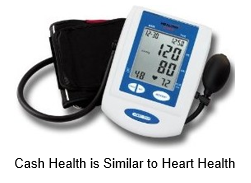
The fastest way to lower your blood pressure is to exercise most days, consume a low-sodium diet, limit alcohol intake, and prioritize stress reduction. Medication alone is never enough.
The equivalent of improving your business Cash Quality is to proactively, not reactively manage your business activities. Don’t just let things happen. Stop consuming things your customers won’t value or pay for to reduce your weekly cash outflows to build healthy cash reserves, and you will reduce your stress.
Overview
Just as Net Profit is what’s left over from your Net Sales after you pay all of your expenses in its purest form, cash health is your ending balance after you subtract all of your cash outflows from your beginning cash balance plus cash inflows.
Put another way, you are a break-even business if you are trading one dollar for four quarters. Less than four quarters collected on every dollar sold is a loss, just as anything over four quarters on a dollar sold is profit.
If you put this in medical terms, your pulse indicates heart health. You learn your pulse pressure when your blood pressure is taken. The calculation starts with the top number (systolic) less than the bottom number (diastolic) to arrive at your pulse pressure. For example, if your resting blood pressure is 120/80 millimeters of mercury (mm Hg), your pulse pressure is 40 — which is considered a normal and healthy pulse pressure.
Your systolic (top) number refers to the amount of pressure in your arteries during the heart muscle contraction. Diastolic is the bottom number that refers to your blood pressure when your heart muscle is between beats.
Scientists have determined that systolic blood pressure (the top number), or the highest blood pressure when the heart squeezes and pushes the blood around the body, is more important than diastolic blood pressure. The value of knowing the bottom number or lowest blood pressure between heartbeats is in its ability to give you the best idea of your risk of having a stroke or heart attack. A high diastolic blood pressure number is what triggers a doctor to prescribe blood pressure medicine.
In business, your gross profit is similar to your systolic blood pressure. It represents the amount of cash available to pay your overhead and leave you a profit after your direct costs are paid.
The business equivalent to diastolic pressure is your cash outflow. This second number measures how much cash you have reserve after your cash outflows are subtracted from your beginning cash balance plus cash inflows. The pressure to sustain the business operations increases when you have little money left over after you pay your direct costs.
The higher the blood pressure, the higher the risk for stroke and cardiovascular disease. It’s as simple as that. Failure to track and manage your blood pressure puts your health and life at risk.
The same is true for the cash health of your business. Fail to produce sufficient gross profits to cover your direct costs, you won’t have any money left over to cover your indirect costs. You correct for this by managing your cash to produce a profit as modeled through the BusinessCPR™ Management System.